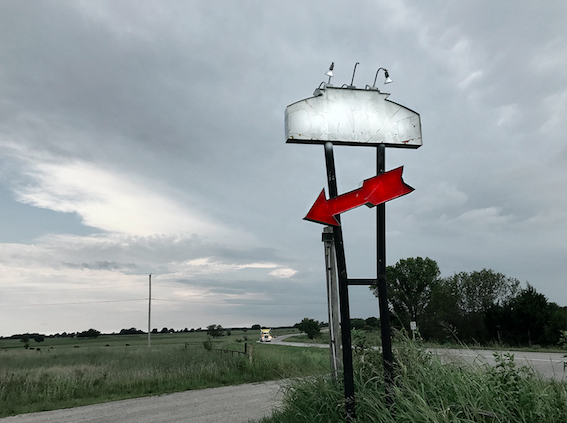The archetype of the wandering artist is a familiar one, emphasizing that the freedom of the road, and the directionless travel that follows is a catharsis that allows an artist to create as freely as possible. For Patrick Beaulieu, the very act of losing yourself on the road is a means to an end, and the documentation of “lost places”—the neglected and decaying areas one finds during a journey—is the art itself. Beaulieu set out in a camper van, “El Perdido” [The Lost], in 2017 and travelled across the United States in search of “The Forgotten Road,” which he described as an ambiguous destination discovered only in the process of searching for it. Running until Oct. 26 at Art Mûr, El Perdido showcases Beaulieu’s photos and videos of his travels, which explain how he set out to lose himself.
To achieve a state of disorientation, which Beaulieu described as a feeling of isolation brought on by the unfamiliar landscape, he often explored undocumented areas of rural decay. His imagery of grey skies and ruined housing allude forgotten places as being lifeless. For Beaulieu, though, the path to losing oneself in the abandoned margins of a map always involved engaging with other people throughout his travels.
“I started in a small town in Oklahoma called Lost City. From [there], the trajectory was generated, influenced, by all the information, the directions, the orientations that the people gave to me. It was kind of a chain reaction from one person to another to try to find these non-existent places,” Beaulieu said. “Specifically in this project, the encounters and relations were essential, because the idea was to try to find a destination that doesn’t exist.”
Along with his interactions, the exhibition displays other tools that Beaulieu imagined as being helpful in losing oneself. On one wall, Beaulieu has two ‘70s-era road maps unfolded and framed. In the creases of the maps, routes end or become misaligned with the adjacent sections, and these segmented images become what Beaulieu refers to as “road map collages,” now rendered useless when considering their original purpose.
In another corner of the exhibition, Beaulieu displays a series of confusing signage and dilapidated billboards that he found during his travels. Here, arrows pointing to nowhere, illegible road signs, and inverted detours create the ignored landscapes that led him to his “Forgotten Road.” Being lost meant embracing the disordered and illogical routes that led to the “modern-day ruins” of rural life, areas often abandoned and erased in an increasingly urban world.
Though Beaulieu often used his environment as a means of becoming lost, he also noted how he could turn to his collaborator Alexis Pernet, who navigated and recorded their travels as diary entries, as a source of disorentiation. He referred to himself and Pernet as “co-perdidos” and explained how he asked Pernet, his navigator, to intentionally misguide the pair while on the road. One video, in which Beaulieu repeatedly stops, starts, and switches directions in the middle of an intersection conveys this process of broken navigation.
Throughout all his efforts at becoming lost, Beaulieu noted that though he’d had no expectations before beginning the project. He’d now arrived at a more personal definition of what being lost meant. Calling the project a ‘long term and monumental performative state,’ Beaulieu likened himself to a tourist whose self-inflicted sense of being adrift had led him to a forgotten world, itself a figurative space that reflected the lost people it attracted.
“As much as possible, I was trying to be lost,” Beaulieu said. “When you are trying to lose yourself, you find a lost people and you find lost places.”









